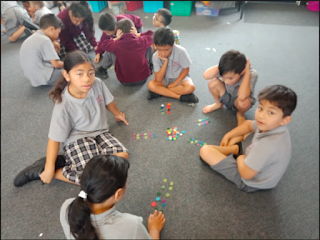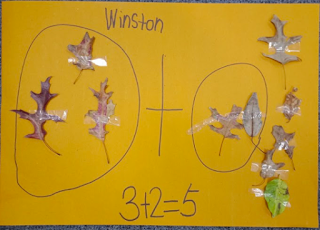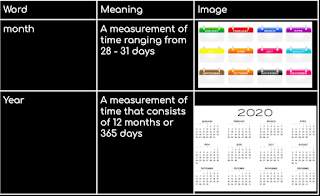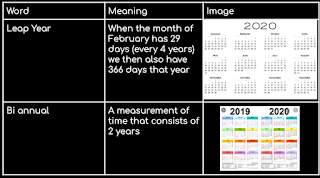On Tuesday after school, I was lucky enough to be given the opportunity to present what my learners had been doing this year at the Manaiakalani Create Staff Meeting held at Stonefields school. It involved hands on creating and an explanation of how in Room 6 we were able to Learn, Create and Share across the curriculum.
Marie Hiddleston Professional Blog
Wednesday 2 June 2021
Monday 24 May 2021
Developing Maths Langugae
Over the past 2 weeks we have been focusing on how to recognise and work out if a number is odd or even. During this time we have made baskets to collect the numbers that are odd and even both physically and digitally.
We looked at how we can look at the last digit of a number to see if the number is odd or even. During our sharing time myself or one of the students would re-voice what a student said for example:
Student A: 38 is an even number because of the 8
Teacher: So are you saying because the last digit is an 8 it is an even number?
Student A: Yes, that last number is 8 and I know that the numbers that end with, 2, 4, 6, 8 or 0 are even numbers.
Student C: I know that numbers that end with a 1, 3, 5, 7 or 9 are odd numbers.
Teacher: Yes that last number or digit helps us to see or decide if it's an odd or even number.
I then explained to the students that we would also be able to share the number between 2 and if both people got the same or equal amount for example: 7 and 7 it would be an even number, but if the people got different for example: 7 and 8 it would be an odd number.
I then set a task for students to work out odd and even numbers through sharing. I assumed, in error, that my students understood sharing as we share our scissors, we share games, and we had talked about what sharing looked like and even did an example on the mat of sharing the marbles between 5 people.
When students worked independently working out if a number was odd or even by sharing we ended up with all sorts of results.
Student A: 10 + 8 =18 this is an even number because they both end in an even number (meaning the 10 and the 8).
Student B: 10 + 15 = 25 this is odd because the total ends in a 5
Student C: 9 + 7 = 16 this is odd because the two numbers are different (the 9 and 7 are not the same).
I stopped the session and decided to try again the next day with a different approach. We begun our session by making groups of 5 or 6 and placing counters in the middle, for the students to share among themselves. After a short amount of time I stopped the students and asked them to count how many counters they each had. Not one of the groups had the same amount as each other we had 9,12,11 all from the same group.
I then asked the students if we share equally what would that look like. After much discussion one student stated that thinking about the word equal we should all have the same. Other students agreed with, yes that's right, Yea equal means the same. We then tried the process of sharing again. This time we had a little more success in that 2 groups were successful at sharing equally. I then asked these groups to share what they had done to be successful.
They shared with the class that they took turns I re-voiced this and said so you are saying that each person had to take a turn in the correct order is that correct because I know some of the other groups took turns but they didn't end up with equal or the same amount of counters.
Student A: Yes Ms that is right you can't take your turn until the person beside you has had their turn.
Teacher: Ok let's try that again.
Here are some images of us sharing equally so that we all have the same.
Now that we can equally share in a large group we are going back to having a partner to see if the number is odd or even.
Teacher: When we are sharing our number how will we know if the number ends up being an odd or even number?
Student A: I think there will be a counter left over in the middle because we both have to have the same for it to be an even number.
Student B: Yes if one person has 1 more than the other it is an odd number.
Teacher: So if we lined up outside and I said that I wanted two equal lines would that be an odd or even number?
Student C: I think if the numbers were both the same the number would be an even number.
We then proceeded to line up outside, we had 13 in one line and 14 in the other line.
Student D: Ms if we turn to our partner and hold hands if everyone can hold hands with someone we will have an even number.
Student E: Ms I don't have a partner, I'm the odd one out. Our number must be odd.
The next few days whenever we lined up to go somewhere my students wanted to work out if they had an odd or even number. I have since set an odd and even task where students used both the strategies of working out an odd or even number (last digit and equal sharing). Although most students prefer to use the last digit strategy (because they have realised they can work out if a number is odd or even whatever the size of the number) I knew that it was important for them to have the knowledge and understanding of equal sharing, especially as we move on to multiplication and arrays.
Wednesday 5 May 2021
Developing my Oral Language Programme Across the Curriculum
This week I have been trying to access my students prior knowledge by remembering to include reading, talking and writing to help my students to make connections, and to make my sessions full of rich oral language.
Our poem of the week was Autumn Leaves. Before introducing the poem I asked my students if they could tell me anything about seasons. One student asked if summer was a season, I replied with yes summer is a season, we have four seasons. Can anyone think of another season which in turn led to us writing down the four seasons; Spring, summer, Autumn and Winter.
I followed this up by asking my students what season they thought it was now and provided the options of where to move to in the classroom if they believed the season to be Spring, Summer, Autumn and Winter. All seasons were covered by this activity. I then proceeded to ask each group why they thought it was their chosen season.
Spring: I know we have had summer, so I think it is Spring.
Summer: The sun is shinning and it is hot. (These students were sat next to the window and the sun was flowing through the windows).
Autumn: I have been seeing the leaves and they are orange and brown.
Winter: In the morning it was very cold and the grass is cold and wet when I walked across it.
I continued to explain how they all had very good reasons for choosing the season they had. I then asked do you know what colour the leaves on the trees would be for the different seasons. One student then went to gather some leaves that were on the ground for us to look at. After further discussion we agreed with Autumn being the correct season.
Our poem was then introduced and we talked about how we could describe the action of the leaves as they fall from the trees. The students came up with words like drop, fall, fly, blow all of these were provided in sentences. I then agreed that they had good sentences and provided another word, flutter with the sentence: The leaves flutter like a butterfly down to the ground. The student then added to my sentence words like, slowly fluttered, softly fluttered.
After going over our poem my students then glue this into their books and draw a background that suits the poem. Here are two examples:
After our poem we moved onto maths. we have been looking at making groups to five using simple addition and subtraction. I decided that we would make a display of these facts using the autumn leaves. Here are a few examples of our autumn facts to five.
Sunday 2 May 2021
Manaiakalani T.O.D.
Manaiakalani Cluster Teacher Only Day
- Teacher willing to share the power with the students in class, Making sure to value a students first language. This doesn't mean that the teacher must be fluent in this language.
- As a reader if we don't know or understand the context our predictions will not connect to the topic. (Dr Si'ilata provided a great example where we were asked to fill in the gaps of a text, without prior context. We all read the text as though it was about cleaning our teeth, but when the context was revealed it had been about a chicken farmer and how to stop his hens from getting infections).
- As teachers we need to provide texts that are mirrors to our students. This could be a text set in their homeland, a craft or art, faces of characters that reflect back the students faces of home.
- Don't teach words in isolation, it is much more meaningful in chunks when learning a new language.
- Use and access the Dual language books, these are also available as audio.
- Use the resources we have available, Our Students.
- The follow up activities should build on purpose and students should be practising the strategies learnt during this time.
- Students only receive 20% of the reading time with the teacher make it good.
- Provide tasks that require them to read for a purpose, Skin in the Game.
- Don't spend to much of your reading time on what is expected in the follow-up activity. This could perhaps be covered in your writing sessions.
Jo shared at the beginning of her presentation how her school had been running Personal development sessions over two years with Dr Jannie Van Hees, who has developed many educational resources and programmes around the use of language and culture.
Deep Dive
To allow their students experiences to grow the school now has a deep dive topic every two weeks. This is a short breakdown of what those two weeks would look like.
Topic - Water
What do you think of when you hear the word water?
eg. bath, pool, tap, river, raining ...
This allows for prior knowledge language to be shared. Next a discussion on what water looks like, feels like. Where lots of different ideas can be shared and explored.
A video was then shared with the students Ranginui the sky father
A Tongan book - Walking in the Rain a dual language book (audio available)
Gifting of vocab when looking at the water cycle - This is provided with visual pictorials drawn by the teacher. At this time the teacher is also using lots of oral language eg. the sun makes the water get warmer and warmer and then it begind to evaporate ...
Write and say phrases - (lexical chunking)
Hands on experiences - going outside in the rain, splashing in puddles, dancing, Experiments displaying the water cycle etc.
Provide talking frames - provides the correct vocab to experience and practise.
Say and Do - what ever the teacher has to do, they explain in detail use correct language (no dumbing down).
eg. I taking my bucket to the tap, I'm holding my bucket under the tap, now I'm turning the tap on. I don't want to over fill my bucket so I'm going to turn the tap on slowly ...
Session Three: T Shaped Literacy for Juniors - Rebecca Jesson link
This is wide reading for high order thinking - 5+ a day.
Shared, Guided, Buddy, Independent - Practice. endurance, resilience.
- Independent reading - doesn't matter if it is not perfect
- Explicit vocab
- Talking/Wide reading - strategies to learn the words themselves, to gain word knowledge.
- Reading involves - talking, reading, writing (To connect)
- layer the learning over a week with 5+ texts
- Before reading - get prior knowledge out (discuss the book)
- Read the book - oral language
- Different meanings - across language
- Make meaning of the text - everyone can we have been making meaning since the day we were born.
- Provide provocation - Theme, transferable ideas:
- Link books - How to get help, Keep Trying, (Choose various texts covering this theme)
Friday 2 April 2021
Ideas and Thoughts for the 2021 Year
This year our shared aim for 2021 is to produce a 1 ½ times accelerated shift for all students with a focus in maths, but of course, if this can be transferred across all curriculum areas, this would be amazing!
I found this clip on 'You Cubed' about brain science and thought it fit with our shared aim perfectly.
Our school year began with a teacher only day (T.O.D.) on maths with Marie Hirst. She has provided us with hands on activities that will engage our students from the very beginning. She discussed strategy of 'talk moves' that promote classroom conversations centred around maths but again, I feel this could be transferable across all curriculum areas.
This is the template for Talk moves that I have decided to use in my class of year 2/3 learners.
 |
Friday 27 November 2020
Tuesday 22 September 2020
Designing a Digital Maths Dictionary
My main focus of inquiry this year is word vocabulary through all curriculum areas. last week my students and myself have begun putting together a digital math dictionary to help with all the math language that we have been learning over the year.
Our first slides are all around time. I have tried to keep the language child friendly while still providing the correct language. To help me do this I have three columns, the first has the maths word, second the math meaning and third I have tried to add an image to help with understanding.
We will continue to add to this as we discover new maths language. I will also be adding the link to my class slides as from next term, so that my students can have easy access.













